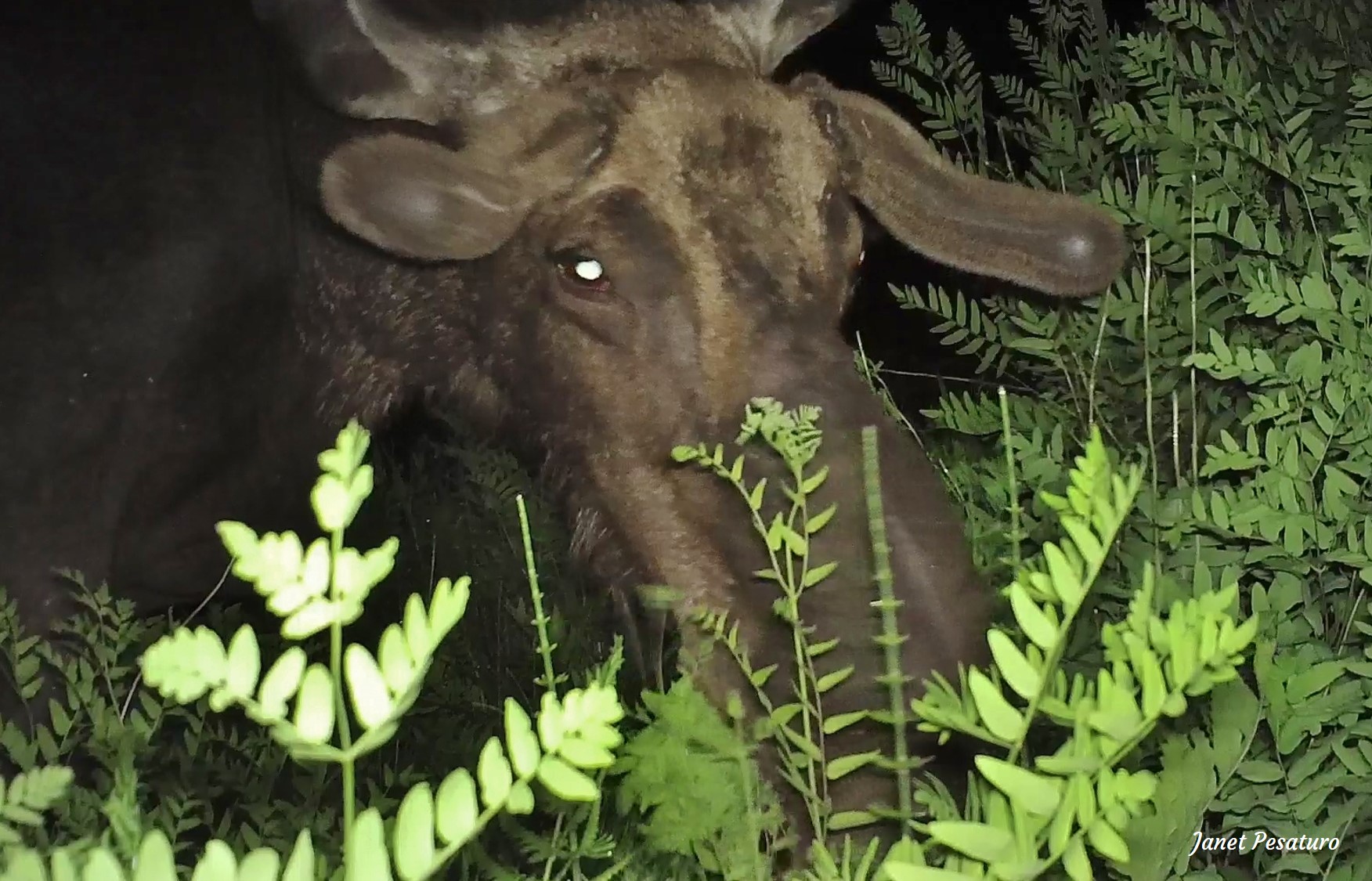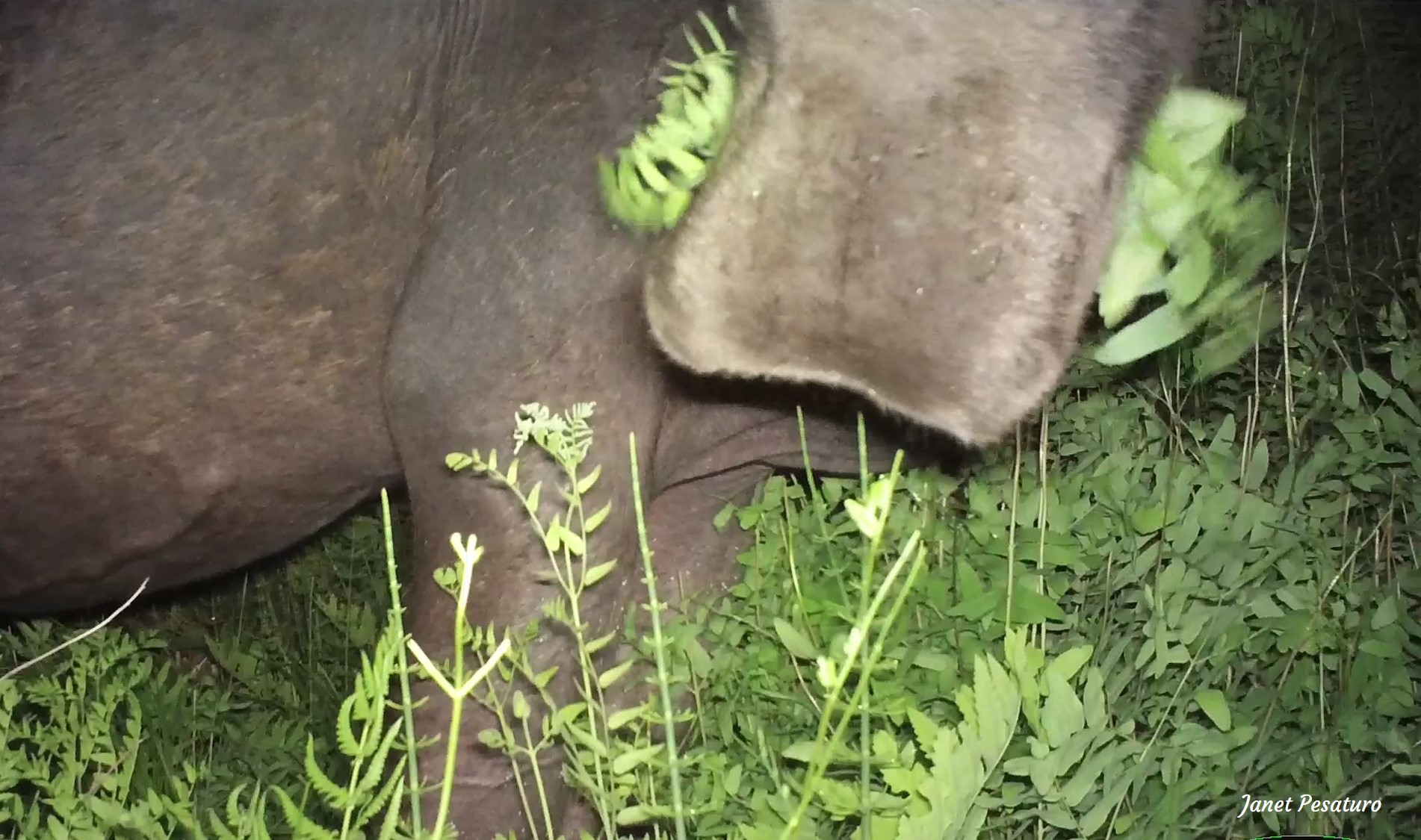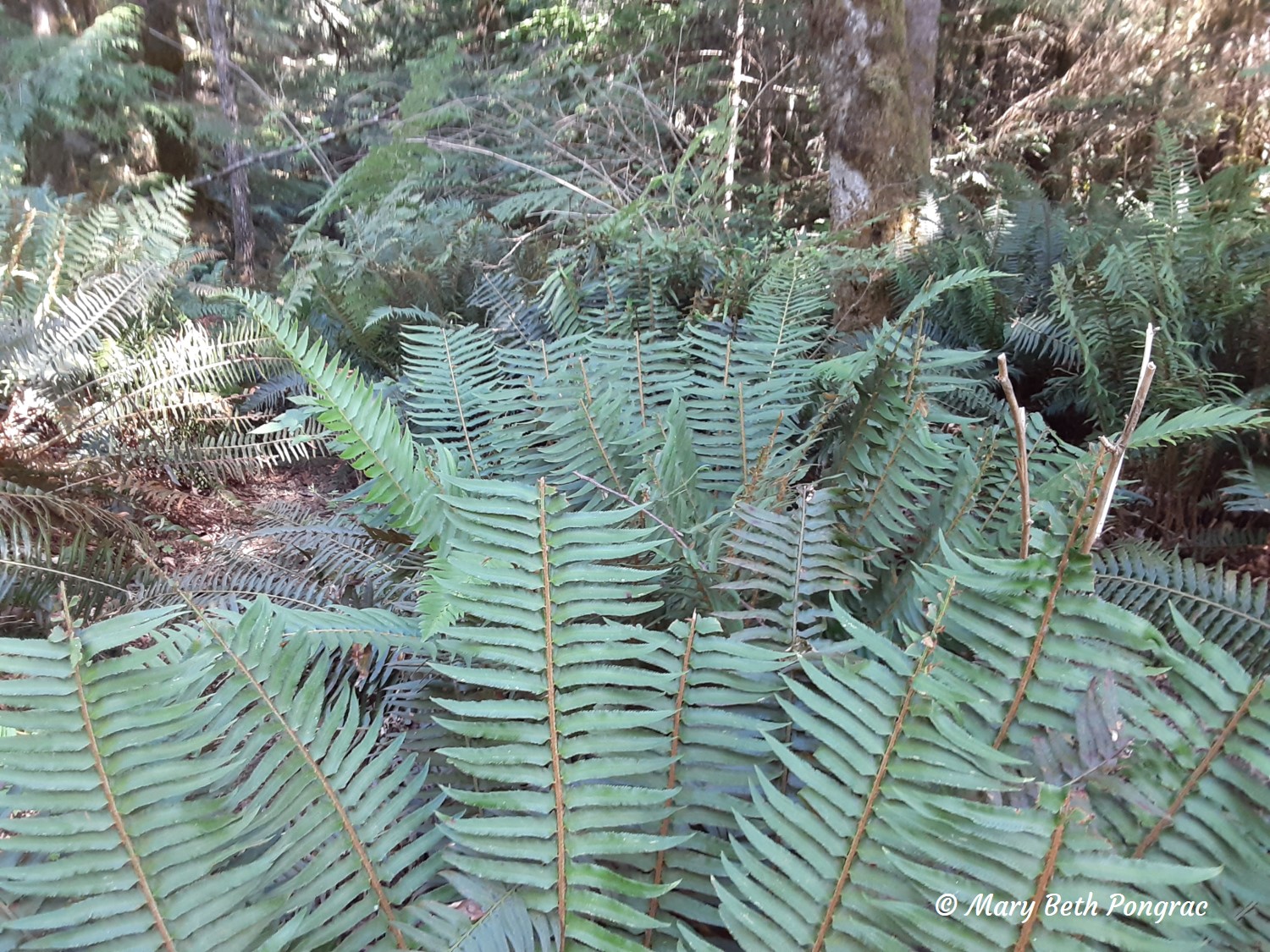Moose and Ferns: Feeding Sign and Importance

Moose (Alces alces) are known to consume a wide variety of plants, favoring the leaves and twigs of trees and shrubs and aquatic vegetation where available. Ferns are mentioned only occasionally. In his 1934 study of moose diet on Isle Royale, Adolph Murie reports that moose consume several fern species, especially wood fern, but also bracken fern, Lady Fern, Virginia Grape Fern, and Royal Fern. The video below, captured at the edge of a Massachusetts pond, shows a moose eating heartily of royal fern (Osmunda spectabilis, aka Osmunda regalis spectabilis). Watch him eat and then let’s consider the feeding sign he creates and the value of ferns to moose and other wildlife.
Feeding Sign on Ferns
In the above video, the moose does two things to the fern as he feeds: Sometimes he strips the pinnae (leaf-like structures) off the rachis (stem-like central axis) by running the fern through his mouth. And sometimes he simply tears off a large part of the blade (the leafy part of the fern).
Moose feed on twigs in exactly the same way: They strip and they tear. You can see a moose stripping twigs here. When moose instead tear twigs, they leave ragged ends due to the lack of upper incisors, as seen and explained here. The feeding sign left on ferns is similar, but frayed ends don’t show on the thin, non-woody rachis, so it’s hard to tell whether a fern was torn by an ungulate or cleanly cut by a rodent or rabbit. But, stripped pinnae suggest ungulate. I don’t know if deer strip ferns in this way, but now we know that moose do. Here is a frame from the video showing the feeding sign.

Value of Ferns to Moose
Since ferns are only occasionally listed on the moose’s menu, they may be insignificant overall, but it’s possible they provide important nutrition to some moose in some locations. I wonder if ferns are important to moose here in Massachusetts. Moose diet hasn’t been well studied here in the southern limits of its range, where plant communities differ from those in the heart of moose country up North. Also lacking are studies on many fern species. I couldn’t find a nutritional or toxic analysis of royal fern, though some ferns are known to contain toxic or carcinogenic compounds.
In addition to the leafy green parts, ferns have something else to offer: rhizomes. A few animals consume the rhizomes of some ferns, but if moose do, I could find no mention of it. Murie refers only to the browsing and grazing of ferns.
What ferns lack that most other plants provide and that moose enjoy, are flowers, seeds, and fruit. Ferns do produce spores which contain some protein, fat, and carbohydrate, but because they are so tiny and encased in tough cell walls, most probably pass undigested through the intestinal tracts of most animals who consume them.
Ferns, Wildlife Value, and Unanswered Questions
Despite the fact that some ferns have toxic compounds and none of them offer flowers, seeds, or fruits, I’m beginning to suspect that the wildlife value of some ferns are under-rated for their greenery. In spring and early summer I have often noticed sign of heavy browsing on ferns. Often I am uncertain of the identity of the browser and the browsed, but the sign is common. Luckily, trail cameras sometimes provide illuminating detail. I was excited to catch a moose eating royal fern on video, and my last post featured a photo of a beaver eating ferns. And, in the video below, a beaver munches on ferns starting at about 53 seconds. Have a look at it.
Edit August 4, 2020
As you can see in one of the comments below, Dan Gardoqui says stripping of ferns by ungulates has been called by Mark Elbroch “diastematic stripping” because the animal grips the fern in the diastema, the space between the incisors and the premolars.
Mary Beth Pongrac points out that western sword fern (Polystichum munitum) is an important food source in the Pacific Northwest for both Roosevelt elk and black-tailed deer. She has provided a photo of elk feeding sign on this fern. It’s interesting that it looks a little different from moose browsed royal fern, in that the frond tips are bitten off, with minimal stripping of the pinnae. That is, the fern is browsed and not stripped.

It’s time for me to hone my fern identification skills and to start determining who is eating and which fern species it’s eating. Have you noticed feeding sign on ferns? Have you observed moose or other animals eating them? Feel free to share your thoughts, observations, and questions in a comment below.
Sources
Murie, A. The Moose of Isle Royale.” Miscellaneous Publications of Museum of Zoology University of Michigan. 25 (1934): 1-44.

Janet,
Great post! Thanks for sharing this feeding behavior and associated sign. You mention a question about white-tailed deer and feeding on ferns. I’ve seen very strong evidence of this in my area – mostly deer stripping different fern species (inlcuding royal fern)- likely by gripping them in the gap between the incisors and the premolars (aka the diastema). I believe Mark Elbroch – many moons ago -referred to this as “diastematic stripping” in ungulates as well.
Ah, very cool. So deer strip ferns in the same way. Thanks for sharing that observation. I am pleased to add the term “diastematic stripping” to my tracking vocabulary 🙂
Hi Janet.
Thanks for posting this and for your research. On the short trail that I take to one of my trail cams (the one that gets all the elk!), I noticed a lot of browsing on Sword Ferns. Thanks to your posting, I researched Roosevelt Elk’s use of Sword Fern as a food source, and found this reference: https://www.fs.fed.us/database/feis/plants/fern/polmun/all.html
…and specifically from the article:
“Western swordfern is an important elk food in Douglas-fir forests [67] and other habitats in Oregon and Washington [87,97,102,109,148]. Jenkins and Starkey [108] provide a summary of Roosevelt elk use of western swordfern throughout the Pacific Northwest. The elk consumed an abundance of ferns, including western swordfern, during winter and spring [108]. On the Olympic Peninsula, western swordfern is seasonally important for elk [97,102]. Western swordfern was one of the 10 most frequently used elk foods in the southern Oregon Coast Ranges, and the western swordfern-redwood-sorrel habitat type provided much of the food for elk in both clearcuts and undisturbed forests [16].
Western swordfern is a moderately important food for black-tailed deer year-round [38,74]. Western swordfern made up 13% of the annual diet of black-tailed deer at one site (review [74]), and was found in 27 of the 178 stomach samples from black-tailed deer in western Washington [27]. Western swordfern was among the most common species browsed by mule deer in the western hemlock/salal/western swordfern and the Pacific silver fir/western swordfern-redwood-sorrel associations on the Olympic National Forest. Deer sign was frequently observed, and recent activity was noted in late summer [97]. Klein [117] observed heavy spring use of western swordfern by mule deer on Coronation Island in southeast Alaska, despite its apparent low palatability.”
I’m in British Columbia, Canada, but the habitat is very similar to that described above in Washington and Oregon. My guess is that on this trail, even though it is also frequented by Black-tailed Deer, it is the Roosevelt Elk that are eating it. The reason for this is because of the height of the ferns. They’re about 4.5 feet tall and it’s just the top parts that are eaten. I think that Black-tailed deer wouldn’t be able to browse the tops as the deer aren’t not tall enough.
I may have a video of an elk eating a sword fern. I’ll try to find it and if I can, will either post it here or on the Trail Camera Photos and Videos Facebook page. If you’d like, I can take photos of the browsed ferns. Please let me know.
Thanks again,
Mary Beth Pongrac
Excellent info, Mary Beth! It certainly challenges the notion that ferns in general are of poor wildlife value. Do you have a youtube channel? If so, and if you do have a video of an elk eating western sword fern, please post it on youtube and I could write an addendum to the post and embed the video into it, if it’s okay with you. A photo of the feeding sign would also be wonderful – I’d love to see it. Thanks for sharing!!!
Hi Janet.
I have a youtube channel: https://www.youtube.com/channel/UCtCZLzQBr8pM3xhKJyib2JQ
and if I have a video showing an elk eating western sword fern, I will definitely post it there. If I do, it’s perfectly fine for you to embed your video into it.
The next time I check my “elk trail cam”, I’ll take photos of the browsed ferns and send them to you. I’ll probably be going in a few days.
Thanks very much, Mary Beth!
Hi Janet.
Unfortunately, I wasn’t able to find a video that shows elk eating the ferns. A bit frustrating, as there are several of them with the elk chewing foliage, but it isn’t evident that it’s ferns they’re chewing (also chewing their cud, but that’s another thing altogether!).
Nevertheless, I took some photos of the ferns that have been chewed/eaten. The photos were taken along the path that the elk take through the woods. You can see that sometimes they strip the leaves off, leaving the rachis, as you identified in your blog above, and sometimes they take the rachis and the leaves.
The ferns in the photos are about 4 feet tall.
I’m not able to attach the photos. Could you please let me know another way to send them to you. Thanks.